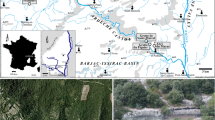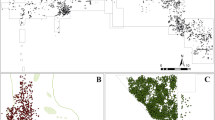Abstract
Zooarchaeological research on assemblages from deeply stratified sites in historic towns is complicated by the reworking of bones through intercutting and disturbance. Conversely, structural association with buildings and property boundaries may allow detailed spatial analysis, and interpretation at a close contextual level that reveal small details of people’s lives. Five years of excavation at the Hungate site in York has yielded a very large animal bone assemblage ranging from Roman to early modern times. Assessment of this assemblage has focussed on identifying context groups of good integrity and high research value. In this paper, we present preliminary results from Hungate to show the potential of contextual analysis in urban deposits, and the challenge presented by redeposition and time-averaging.







Similar content being viewed by others
Abbreviations
- YCA:
-
York City Archives
References
Billson RA (2009) Always look on the bright side of taphonomy: Animal bones from the excavation at Hungate, York. Unpublished MSc dissertation, University of York
Bond JM, O’Connor TP (1999) Bones from medieval deposits at 16-22 Coppergate and other sites in York. The Archaeology of York 15/5. Council for British Archaeology, York
Carrott J, Hall AR, Kenward HK, Large F, Milles A (1995) Assessment of biological remains from excavations at Vicars’ Court, Lincoln (site code: VC93). Reports from the Environmental Archaeology Unit, York 95/36 (unpublished)
Dobney K, Kenward H, Roskams S (1997) All mixed up but somewhere to go? Confronting residuality in bioarchaeology. In G. De Boe & F. Ver Haeghe, Method and theory in historical archaeology. Papers of the “Medieval Europe Brugge 1997” Conference 10. I. A. P. Rapporten 10. Zellik.
Hammond C, O’Connor T (2013) Pig diet in medieval York: carbon and nitrogen stable isotopes. Arch Anthropol Sci 5(2):123–127
Keaveney EM, Reimer PJ (2012) Understanding the variability in freshwater radiocarbon reservoir offsets: a cautionary tale. J Archaeol Sci 39(5):1306–1316
Morris J (2011) Investigating animal burials: ritual, mundane and beyond. British Archaeological Reports British Series, Oxford, p 535
Nielsen-Marsh CM, Hedges RE (2000) Patterns of diagenesis in bone I: the effects of site environments. J Archaeol Sci 27(12):1139–1150
O’Connor TP (1988) Bones from the general accident site, Tanner Row. The Archaeology of York 15/2. Council for British Archaeology, London
O’Connor TP (1989) Bones from Anglo-Scandinavian levels at 16-22 Coppergate. The archaeology of York 15/3. Council for British Archaeology, London
O’Connor TP (1991) Bones from 46-54 Fishergate. The archaeology of York 15/4. Council for British Archaeology, London
Rainsford C, O’Connor T, Connelly P (2014) The embarrassment of riches: rationalising faunal assemblages from large urban sites. Int J Osteoarchaeol. Article published online: 29 AUG 2014, DOI: 10.1002/oa.2412
Roskams S, Saunders T (2001) The poverty of empiricism and the tyranny of theory. In: Albarella U (ed) Environmental archaeology: meaning and purpose. Springer, Netherlands, pp 61–74
Smith CI, Nielsen-Marsh CM, Jans MME, Collins MJ (2007) Bone diagenesis in the European holocene I: patterns and mechanisms. J Archaeol Sci 34(9):1485–1493
Tague IH (2008) Dead pets: satire and sentiment in British elegies and epitaphs for animals. Eighteenth-Century Stud 41(3):289–306
Thomas R (2010) Translocated Testudinidae: the earliest archaeological evidence for land tortoise in Britain. Post-med Archaeol 44(1):165–171
Acknowledgements
This project was undertaken by CR with active supervision from TPO’C whilst CR was employed by York Archaeological Trust. The authors would like to acknowledge all those at York Archaeological Trust, volunteers and staff, who provided time and support to ensure the smooth running of the project. Dr. Jayne Rimmer kindly provided the documentary information and interpretation. We also thank Lee Broderick and Richard Madgwick for organising the ‘Bones in Space’ session at ICAZ 2014 at which this paper was originally presented, and the two anonymous reviewers for their comments on the paper.
Author information
Authors and Affiliations
Corresponding author
Rights and permissions
About this article
Cite this article
Rainsford, C., O’Connor, T. Taphonomy and contextual zooarchaeology in urban deposits at York, UK. Archaeol Anthropol Sci 8, 343–351 (2016). https://doi.org/10.1007/s12520-015-0268-x
Received:
Accepted:
Published:
Issue Date:
DOI: https://doi.org/10.1007/s12520-015-0268-x




